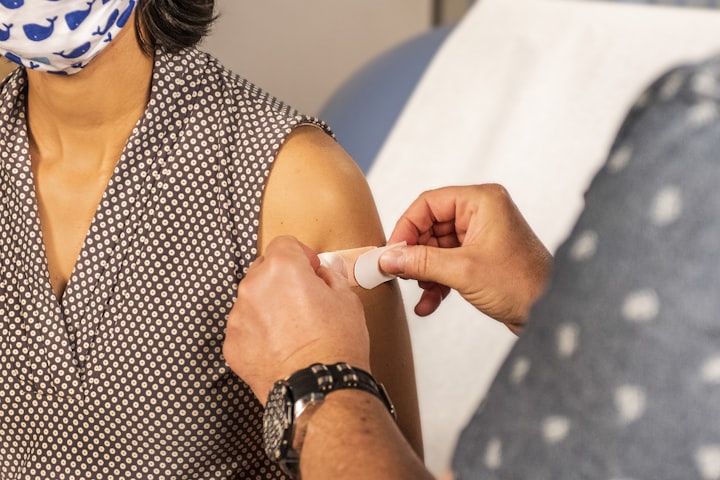Planning in Distributing Vaccines Fairly According to WHO.
Countries must fight for adequate supplies, distributing vaccines as quickly as possible to vaccination sites.
"The world is on the brink of a catastrophic moral failure – and the price of this failure will be paid with lives and livelihoods in the world’s poorest countries."
Dr Tedros Adhanom Ghebreyesus, WHO Director-General,18 January 2021
In a health emergency such as COVID-19, This may include bypassing regional or district storage locations and keeping very limited stocks at one time, or more frequent shipments of vaccine somewhere.
In the context of administering the COVID-19 vaccine, the following will facilitate supply chain efficiency:
staff are trained and can be demonstrate the ability to perform tasks according to standard protocols policies, guidelines and SOPs are clearly written, updated based on vaccine profiles, and disseminated to relevant parties through various sources, including mobile communications; available and accessible operational tools, including those required for recording, reporting and monitoring, warehousing infrastructure is designed to ensure safe and smooth operations (receiving, storing, repackaging, transporting and monitoring) during vaccine handling and logistics.
inventory is updated, storage and transport capacities are adequate, equipment is functioning and maintained, and systematic temperature monitoring is implemented.
including a backup generator, available at the facility, security measures are in place to prevent vaccine theft during storage and transportation.
Communication can be clearly defined, including reporting requirements for those who need it more as soon as possible, a strong information management system, for example LMIS, is operational, and data is available to those who need it.
contingency and maintenance plans are clearly written and communicated to responsible personnel, operating budgets are adequate, secured, and made available to supply or facility managers in a timely manner; the role of the private sector is well documented, and oversight.
a fully planned vaccination strategy to reach all groups, including a plan for repositioning as needed; installation of a sustainable and reliable temperature monitoring system, especially on outsourced equipment.
availability of suitable technical support for the installation and management of the UCC equipment energy station.
the availability of strong sustained power and standby generators in facilities housing UCC equipment, availability of special containers for transportation such as Arktek + PCM1 or dry ice and ice boxes; Clear guidelines and SOPs on UCC use and maintenance, including UCC application and re-positioning of equipment and PCM management.
contingency plans that are communicated, disseminated and tested; and all responsible personnel are trained and demonstrated the ability to manage UCC according to SOPs and are provided with appropriate PPE (e.g. cryogenic gloves) for COVID-19 vaccine with UCC profile (-70 C) will pose some challenges for many LMICs, such as lack of equipment Existing UCCs, including PCM and ice-producing facilities, are in the health / immunization system a large investment cost given the limited nature of UCC capacity requirements.
many countries will seek to switch to vaccines that can be stored at + 2 C to +8 C and complicated handling and distribution requirements, especially if UCC products have limited stability (eg <7 days) when stored at +2 C to +8 C.
We must accelerate vaccine equity for all health workers now
Health and care workers have been at the forefront of the pandemic response: often under protected and over exposed.
Women make up the vast majority of health care workers and it is thanks to their professionalism, bravery and dedication, often in the toughest of circumstances, that the global mortality rate from the virus is not higher. It is thanks also to their compassion and humanity that those we have lost have been treated with dignity in their final moments.
Due to unprecedented scientific efforts, vaccines are now being distributed in more than 70 countries across the world, with health workers in those places rightly among the first groups to receive them. In the majority of low- and middle-income countries, vaccination has not even started which is a catastrophe as hospitals fill up.
We must act swiftly to correct this injustice. Multiple variants are showing increased transmissibility and even resistance to the health tools needed to tackle this virus. The best way to end this pandemic, stop future variants and save lives is to limit the spread of the virus by vaccinating quickly and equitably, starting with health workers.
This is why the Director-General of the World Health Organization, Dr. Tedros Adhanom Ghebreyesus, has called all countries to start vaccinating health workers and those people at highest risk of COVID-19 in the first 100 days of 2021.
This is possible if leaders make it a priority. Through the COVAX Facility and the COVID-19 technology access pool (C-TAP) international mechanisms already exist to share know-how, scale up manufacturing and rollout of vaccines quickly and equitably. COVAX, made up of more than 190 countries and economies, has secured 2 billion doses of vaccines in 2021, which will start to be rolled out this month.
To this end, WHO, the undersigned organizations and individuals, call on global, national and local leaders to accelerate the equitable rollout of vaccines in every country, starting with health workers and those at highest risk for COVID-19. This includes scaling up vaccine manufacturing and rejecting vaccine nationalism at every turn.
WHO call specifically for:
World leaders to increase contributions to the COVAX facility and to share doses with COVAX in parallel with national vaccine roll out.
Vaccine manufacturers to share know how with C-TAP to scale up vaccine manufacturing and dramatically increase the global supply of vaccines for the coming years. Furthermore, we ask for leaders to prioritize supplying to COVAX over new bilateral deals.
Regulatory bodies to accelerate approval processes in a safe and deliberate way.
Ministries of Health to work with WHO and others to invest in and ready their primary health care systems for distribution of COVID-19 vaccines to their health workers and to develop data systems on vaccine supply, distribution and uptake, including sex and age disaggregated and sub-national data, to drive delivery, equality and impact.
All governments to ensure that COVID-19 vaccines are distributed free at the point of care and without risk of financial hardship, starting with health workers and those people at greatest risk of COVID-19, and to place affected communities, essential workers, and gender equality at the center of decision-making.
Distributing COVID-19 vaccines quickly and equitably is essential to end this pandemic, restart our economies and begin to tackle the other great challenges of our time, like food insecurity, inequality and the climate crisis.
Health must be foundational to all development in the post-COVID world and investing in primary health care systems will be key to ending this pandemic, preparing for the next one and delivering on the vision of health for all.
People around the world—including the health workers who have carried us through this crisis on their backs—are counting on leaders to do what is right and smart at this pivotal moment. History will judge us harshly if we fail.
In the Year of the Health and Care Workers, we must come together to protect and invest in the people who protect us all, no matter where they live.
-
© World Health Organization 2021.This work is available under the CC BY-NC-SA 3.0 IGO licence.
About the Creator
Viona Aminda
Not a fiction story telling







Comments
There are no comments for this story
Be the first to respond and start the conversation.